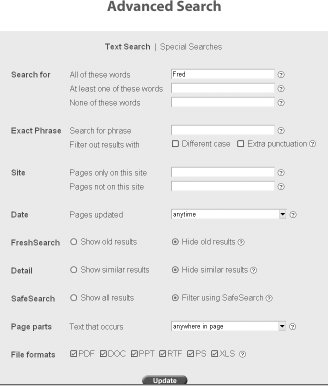|
|
< Day Day Up > |
|
Hack 59. Keep Tabs on Your Searches with Google Alerts
Receive alerts in your email Inbox or RSS reader when something you're after makes its way into the Google Web index or a Google News story. There are two classes of search that one generally runs in Google. One is of the sort that you generally run just the once: you're trying to find information on some topic, a phone number, or that URL you visited yesterday but have since forgotten. Then there's the search that you'd run every day if you could. You're interested in a particular subject matter and want to know the moment Google finds and indexes something new on the topic. There are a couple of services available that'll do the trick: the official Google Alerts notifies you of any new web pages or news stories matching your search criteria, while the third-party service GoogleAlert watches only for new web pages but sports a few extra features and delivery options not found in Google's version.
5.2.1. Google AlertsGoogle Alerts (http://www.google.com/alerts), Google's official alert offering, allows you to monitor both Google's Web index and Google News stories. To set up a Google Alert, visit the Google Alerts page. In the Create a Google Alert form (shown in Figure 5-1), type in a search query and choose whether to monitor news, the Web, or both. Figure 5-1. Monitor Google's Web Index and Google News stories with Google Alerts You have a choice when it comes to how often you're notified: as it happens, once a day, or once a week. Provide your email address, click the Create Alert button, and you'll receive a confirmation email message a few moments later. Follow the link provided in the email message—thus confirming that your email address is legitimate and that it was you who requested the Google Alert—and you're all set.
Each alert that you receive includes your search query, the found page's title, a snippet of content, and the URL (for web index results) or story title, URL, description, and source (for news stories). You can set up to 50 alerts per email address. While all you need to sign up for Google Alerts is a valid email address, there's also the option to sign into Google for a more hands-on approach to managing your alerts. On the Google Alerts page, click the "sign in to manage your alerts" link. You'll need to already have or sign up for a free Google account. But membership has its privileges:
5.2.2. GoogleAlertBefore there were Google Alerts, there was GoogleAlert (http://www.googlealert.com), a third-party alert service built on the Google API [Chapter 9]. Being built on the API, it is kept to only the Google Web index and can't monitor anything like Google News or whatever else Google decides to have the official Google Alerts cover in the near future. However, GoogleAlert does offer a few features worth checking out. Start by signing up for a trial account, which affords you up to three queries.
GoogleAlert's Advanced Search form, shown in Figure 5-2, is similar to Google's Advanced Search page (http://www.google.com/advanced_search), allowing you to build Boolean searches, search for exact phrases, restrict your searches to a particular site or date range, specify the file types that you're interested in, and more—all without having to fiddle with special syntax. Figure 5-2. GoogleAlert offers search extras like case-sensitivity and delivery via RSS You can receive your alerts by email, of course. But you can also subscribe to them as a syndicated RSS feed, or have a page on your weblog pinged by TrackBack (http://www.movabletype.org/trackback/beginners) notification any time something new comes up. Monitoring Google's Web index allows me to find search engines or directories of information that I might have missed otherwise. I keep tabs on Google to find pages that don't tend to appear out of thin air all that often: those containing "online museum" or "online reference service", for example. I tend to use broader search queries when monitoring Google News. While watching the Google Web index for "online database" or "new search engine" might net me thousands of results—and those long after the sites were actually new—online news stories about new online databases and search engines tend to crop up less frequently and provide a higher signal-to-noise ratio. |
|
|
< Day Day Up > |
|